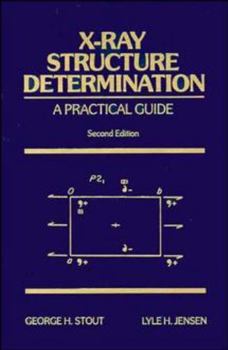X-Ray Structure Determination: A Practical Guide
Select Format
Select Condition 
Book Overview
Closely follows an actual structural determination. After some introductory material on the nature of x-rays, the diffraction process, and the internal geometry of crystals, the selection and preparation of a crystal are considered. Techniques of measuring raw x-ray data are covered, plus their reduction into a useable form. The second part discusses both traditional and novel methods of solving the ''phase'' problem, the principal difficulty in x-ray structure determination. The third part considers how to extract the most information from the data and how to evaluate its reliability. Finally, there is a discussion of sources of error in practice and interpretation.
Format:Hardcover
Language:English
ISBN:0471607118
ISBN13:9780471607113
Release Date:April 1989
Publisher:Wiley-Interscience
Length:480 Pages
Weight:1.70 lbs.
Dimensions:0.9" x 6.4" x 9.6"
Customer Reviews
2 ratings
Complete and rather mathematical. Also outdated.
Published by Thriftbooks.com User , 16 years ago
With many good graphics, this book explains it all. From the beginning (generation and diffraction of X-rays) to the end (errors and ambiguities of the method), almost everything you ever wanted to know (and more) about the method of X-ray structure determination is explained here. The approach Stout and Jensen take is a rather theoretical and mathematical one, which does not cater to everybody's preferences. I personally prefer Carmelo Giacovazzo's Fundamentals of Crystallography, but the Stout and Jensen certainly is a classic and a whole generation (and a half) of crystallographers was raised on it. Unfortunately the book is a little outdated and more recent developments like area detectors are not mentioned. The part on structure refinement is interesting (especially the section on scaling) but hopelessly incomplete. For practical structure refinement go with Peter Mueller's Crystal Structure Refinement -- A Crystallographer's Guide to SHELXL.
introduction to the basics, at least in theory
Published by Thriftbooks.com User , 22 years ago
This book is an excellent excellent introction to the basic physics and math of x-ray crystallography. This was used as the text in an undergrad class I took on protein crystallography and it was perfect for that purpose. The main drawback of this book is that it is really concentrated on small molecule structure determination, and doesn't address the problems or specific techniques used for large protein structures. So probably the best way to use this book would be in conjuction with a more protein-specific book. But for the raw fundamentals of symmetry and diffraction, I don't think you can beat stout & jensen.






